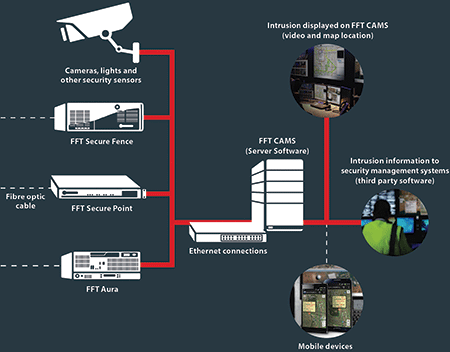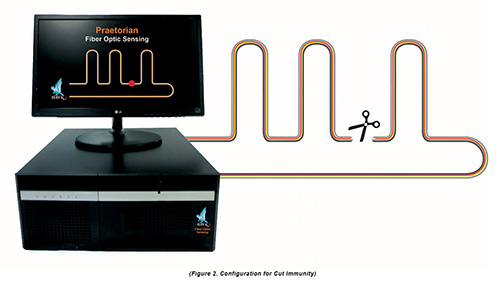Why Choose a Fiber Optic Security System for Maximum Security and Efficiency
Why Choose a Fiber Optic Security System for Maximum Security and Efficiency
Blog Article
Why Fiber Optic Safety Equipments Are the Future of Defense
The shift to fiber optic security systems notes a considerable advancement in the realm of protection, driven by their exceptional information transmission abilities and strength to outside disturbances. These systems not only promote faster and much more reliable communication but likewise present an economical service with lowered maintenance demands. As the landscape of safety and security evolves along with emerging modern technologies such as AI and IoT, the capacity for optical fiber to improve and redefine security facilities becomes progressively evident. The ramifications of these improvements elevate crucial concerns regarding the future of safety steps and their efficiency in an ever-changing setting.
Benefits of Fiber Optic Equipments
Among the main benefits of fiber optic systems is their exceptional bandwidth capacity, which facilitates the transmission of large volumes of data over cross countries without substantial loss. This particular is especially beneficial for security applications that call for the constant tracking and transfer of high-definition video clip feeds, sensing unit data, and other crucial information. Optical fiber can fit the growing demands of modern-day protection systems, making certain that information stays intact and reliable.
In addition, fiber optic wires are much less vulnerable to electromagnetic disturbance, which can be a substantial problem in environments with numerous digital devices. This resistance boosts the stability of the data being transferred, thereby decreasing the danger of data violations or system failures. Fiber optic systems are inherently a lot more safe than standard copper cable televisions, as touching right into a fiber optic line without detection is exceedingly hard.
The resilience of fiber optic cords likewise adds to their charm. They are resistant to environmental aspects such as dampness and temperature level variations, minimizing maintenance expenses and increasing system durability. On the whole, these advantages position fiber optic systems as a robust and effective option for contemporary security infrastructures, guaranteeing reliable and secure data transmission.
Enhanced Data Transmission Rate

The capacity to transmit large quantities of information quickly assists in the smooth integration of high-definition video clip feeds and advanced analytics. Safety and security systems can currently refine and assess information in real-time, enhancing feedback times and situational awareness. Furthermore, fiber optic links support longer transmission ranges without destruction of signal top quality, making them excellent for extensive safety networks.
The enhanced speed of fiber optic systems not only enhances the effectiveness of protection procedures yet additionally lowers latency. This is specifically crucial in essential scenarios where prompt decision-making can stop safety breaches or reduce potential threats. As organizations remain to focus on security and effectiveness, the demand for fast and reliable information transmission will undoubtedly strengthen fiber optic systems as a keystone of contemporary safety and security facilities.
Resistance to Interference
Fiber optic security systems consistently show remarkable resistance to electromagnetic interference, an important advantage in atmospheres vulnerable to digital sound. Unlike conventional copper cords, which can be negatively impacted by magnetic fields, radio frequency interference, and other forms of electric disruption, fiber optic cables make use of light to transfer information. This integral residential property makes sure that the signals stay clear and unaltered, regardless of bordering electronic task.
Making use of glass or plastic fibers in fiber optic technology develops a barrier versus interference, enabling trustworthy data transmission also in challenging circumstances such as industrial centers, metropolitan locations with high electronic web traffic, or locations near radio towers. This particular significantly lowers the possibility of signal destruction or loss, making fiber optic systems especially suitable find more for protection applications where stability and precision of data are paramount.
In addition, this resistance to interference boosts the general efficiency and integrity of safety systems, making certain that monitoring and sharp systems function flawlessly. In a world where safety is significantly threatened by sophisticated technologies, the strength of fiber optic systems attracts attention as a pivotal attribute, enhancing their status as a crucial component of modern safety and security facilities.
Cost-Effectiveness Gradually
Substantial price financial savings can be attained with time with the basics implementation of fiber optic security systems. While the initial investment may seem greater contrasted to traditional copper-based systems, the long-term financial advantages become apparent via reduced operational and upkeep prices (fiber security). Fiber optic wires are naturally extra sturdy and much less vulnerable to environmental factors, which translates to decrease substitute and repair service costs over their life expectancy
Furthermore, fiber optic systems require less power to run, which even more decreases energy prices. Improved information transmission abilities permit less repeaters and amplifiers, lessening equipment investment and simplifying setup procedures. The scalability of these systems also adds to cost-effectiveness, as companies can broaden their protection facilities without sustaining significant extra expenses.
One more variable to think about is the raised efficiency in tracking and feedback abilities that optical fiber offer. Boosted real-time data transmission can cause quicker incident reaction times, possibly mitigating losses and responsibilities related to safety violations. Altogether, the long-lasting advantages of fiber optic safety systems not just justify the preliminary expense but likewise place them as navigate to this website a financially prudent option for companies looking for robust security services.

Future Developments in Safety
Progressing technologies are established to revolutionize safety and security systems, incorporating expert system (AI) and maker learning to enhance risk discovery and feedback capabilities. These developments will enable protection systems to assess vast amounts of data in real-time, determining patterns and anomalies that suggest possible hazards. This aggressive approach will enable faster decision-making and much more efficient event actions.
In addition, the unification of the Net of Points (IoT) is leading the means for interconnected protection tools, supplying thorough security and surveillance. Smart sensing units can communicate info regarding ecological modifications, while automated notifies can notify safety and security workers instantly of questionable activities.
Moreover, the evolution of biometric modern technologies will certainly additionally boost safety systems. Face recognition, fingerprint scanning, and retina recognition are coming to be a lot more advanced, offering layers of verification that are hard to bypass.
Final Thought
To conclude, fiber optic safety and security systems represent a substantial improvement in security technology, supplying unmatched information transmission speed, resistance to electro-magnetic interference, and lasting cost-effectiveness. As the need for sophisticated security remedies proceeds to grow, the assimilation of fiber optics with arising innovations such as AI, IoT, and biometrics will certainly even more enhance safety infrastructures (fiber security). The mix of these developments will certainly guarantee an extra protected and receptive environment, strengthening optical fiber as a foundation of future protection systems
Report this page